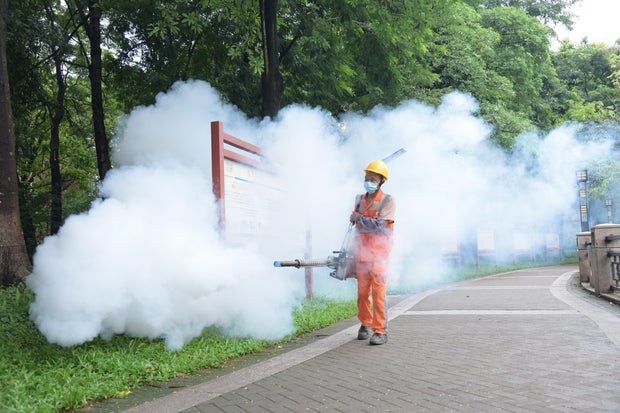CDC Urges Travelers to China to Watch for Chikungunya Surge in Guangdong
Rising Case Count Triggers Level 2 Advisory
American health officials have elevated travel guidance for anyone heading to mainland China after a sharp uptick in chikungunya infections centered on Guangdong Province. The Centers for Disease Control and Prevention now rates the risk at Alert Level 2, advising visitors to take added measures against mosquito bites.
Hot Spot: Foshan Leads with Thousands of New Cases
More than 7 000 locally-acquired infections have surfaced in and around the industrial city of Foshan, an area that sits roughly 100 kilometers northwest of Hong Kong. Most infections have appeared within the last three weeks, sparking concern among regional and global health agencies.
How the Virus Reaches People
Chikungunya does not spread from person to person directly; instead, it is carried by day-biting mosquitoes—primarily Aedes aegypti and Aedes albopictus—that pick up the pathogen after feeding on an infected human and then pass it on with their next bite.
Simple but Effective Ways to Stay Safe
A Virus with African Roots and a Global Reach
First isolated in East Africa in 1952, chikungunya has since staged periodic outbreaks across the tropics. The CDC lists ongoing clusters elsewhere in the world, including Bolivia, Kenya, Madagascar and Sri Lanka, underscoring the disease’s ability to hitch rides with travellers and become established where competent vectors thrive.

South China Battles Chikungunya Surge After Torrential Rains
Downpour-Driven Outbreak Sparks Nationwide Response
An explosive rise in chikungunya cases has gripped southern China following the heaviest rainfall in over a century. Health authorities have responded with sweeping containment tactics—spraying clouds of disinfectant across neighborhoods, stationing mosquito-control teams on every block, and threatening fines for anyone who fails to empty garden pots, buckets or any surface holding stagnant water.
What the Virus Does
Why It’s Easy to Miss
Symulation with Dengue and Zika
Fever, rash and muscle aches overlap among the three mosquito-borne illnesses, creating a diagnostic maze. Mislabeling a case can distort national statistics and hamper control efforts.
Protection and Prevention
For Travelers
For Communities
A Glimpse Ahead
While no drug can kill the virus once it enters the bloodstream, the triple defense of vaccination, vigilant mosquito control, and rapid diagnosis could blunt this sudden surge—and the next—before the rains return.

Dongguan Deploys Rapid-Response Teams After Chikungunya Warning
August 3, 2025 — Streets in one of southern China’s busiest factory hubs echoed with the low hum of fogging machines this weekend as crews advanced block by block, blanketing alleyways and loading docks with mosquito-killing mist. The urgent campaign was triggered by a small but growing cluster of chikungunya infections, the first locally transmitted cases Guangdong Province has faced this decade.
Lightning-Speed Lockdown Mode
Dongguan’s municipal government activated what residents call the “seven-day shield” protocol: every confirmed patient is automatically admitted to hospital isolation for a full week, regardless of symptom severity. Movement permits are suspended; neighborhoods tally twice-daily head counts.
Key Measures in Effect
- Insecticide spraying every six hours in high-density residential zones
- Blood-sample kiosks set up at factory entrances for on-the-spot screening
- QR health passports updated in real time to track exposure zones
- Work-from-home orders for nearly 400,000 employees in the garment and electronics sectors
Beijing’s Post-COVID Rulebook
Chinese officials say the playbook being used in Dongguan was forged during two prior crises: the 2003 SARS outbreak and the COVID-19 pandemic. Central hospitals now stock mobile isolation pods; drones fitted with infrared cameras scout for stagnant water; data rooms run predictive models down to the square kilometer. “Experience shows speed buys us the greatest margin of safety,” noted Foreign Ministry spokesperson Guo Jiakun.
Message to the Public
“The virus is preventable, treatable, controllable.” That concise reassurance, repeated on citywide loudspeakers and bus ticker boards, aims to curb the rumor mill that once fueled panic buying of rice and vinegar during earlier epidemics.
Watching the Numbers
As dawn broke Monday, local health bureaus reported the tally stood at 41 confirmed cases, all tied to a single residential complex adjacent to a wholesale fruit market. No fatalities have been recorded.
In the surrounding Pearl River Delta, air cargo continues to move, metro lines run on schedule, and cranes still pivot above half-finished skyscrapers—signs that China’s newest attempt at surgical containment hopes to keep daily life intact while the war on mosquitoes continues.


